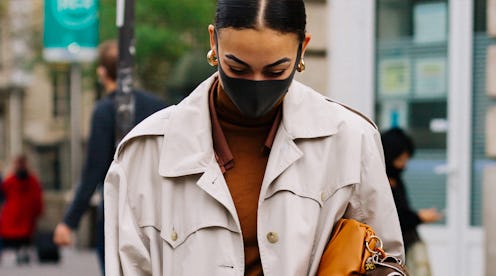(Fashion)
3 Expert Tips For Revamping Your Wardrobe The Sustainable Way This Fall

A new season offers a ripe opportunity to audit your wardrobe. It's a metaphorical reset button that, after a year of change and uncertainty, everyone could make good use of. A byproduct of 2020 is coming to terms with the fashion industry's systemic shortcomings. Lack of representation, labor inequities, and detrimental environmental impacts are just a few of the flaws thrust into the spotlight this year. And as a result, consumers are rejiggering the way they shop, seeking a wardrobe this fall that's sustainable, thoughtful, and useful.
But, experts indicate that there's no one-size-fits-all approach. You may want to start by buying a few secondhand pieces, discovering new small businesses with fair trade practices, or quitting fast fashion for good. Still, committing to a sustainable, ethical approach to fashion requires a larger overhaul, and truth be told, there's never been a better time for it. Ahead, hear directly from leaders in the retail industry on the best steps to take toward building out a truly sustainable fall wardrobe (and beyond) as well as insights that indicate there is a collective shift toward slowing down the fashion industry once and for all.
We only include products that have been independently selected by The Zoe Report's editorial team. However, we may receive a portion of sales if you purchase a product through a link in this article.
How To Create A Sustainable Fall Wardrobe: Consume Mindfully
A common (and unfounded) gripe with sustainable fashion is that it falls outside the realm of luxury — but that's simply not true. Designers like Gabriela Hearst and Stella McCartney prove that an ethical, conscious approach to style is achievable and luxurious. Beyond individual brands, multi-label retailers are also catching on to sustainable luxury, including Net-a-Porter's NET SUSTAIN initiative. "Our [edit] was created to highlight and celebrate the brands sold on-site that meet the business’s criteria for sustainability, offering customers a way to identify those brands and products more easily," Net-a-Porter Senior Fashion Market Editor Libby Page tells TZR. The first phase was launched back in June of 2019. The second, which was launched in January of this year, added 27 beauty brands as well as 45 fashion brands. "Our aim is to give a voice to the brands that are truly making positive changes by providing them with a platform to highlight their best practice," Page explains. "We intend to create and foster change that will be a lasting one throughout the industry."
The pillars of sustainability found within the NET SUSTAIN edit are diverse and offer up a good blueprint on how to mirror these values in your own wardrobe. The key attributes include: locally-made goods, craftsmanship and artisanry, considered ingredients and materials, conscious production processes, waste reduction, and animal welfare.
How To Create A Sustainable Fall Wardrobe: Buy Less
While consciously crafted materials are a component of building a sustainable wardrobe, Trendalytics Content Strategist Kristin Breakell shares that an overall slowing down of the fashion cycle is also on the rise. "I think an interesting thing to note is that sustainable fashion has the highest internet search volume (up 38 percent compared to last year), but both ethical fashion (+52 percent) and slow fashion (+49 percent) have higher growth than sustainable fashion," she shares. Her point being: Consumers are beginning to understand that sustainability is complex and that buying less is — arguably — the best way to achieve your goals of creating an eco-friendly wardrobe.
"This year has made quite a significant impact on the fashion industry as a whole, and that includes sustainable fashion," Breakell observes. "Even before the pandemic, we were seeing consumers shift their preferences toward more sustainable and ethical brands, products, and shopping habits. Now, everyone is being forced to slow down and take a step back." Her hope for the outcome is a new appreciation for items already in our closets. "We don't need as much stuff as we have been conditioned to want," she adds.
How To Create A Sustainable Fall Wardrobe: Embrace Circularity
Vestiaire Collective Co-founder and President Fanny Moizant shares that COVID-19 has had a direct impact on customers' desires to shop resale and vintage. "Consumers are turning to resale and vintage because they are increasingly concerned about sustainability and the impact their choices have on the environment," Moizant tells TZR. She shares that the site's orders have grown by 144 percent year-over-year and that the vintage category has grown by 170 percent as shoppers look to re-invest in trends from earlier decades that are arising once again. "The linear fashion model is no longer sustainable. I believe that the circular economy is the future of the industry," she adds.
This article was originally published on